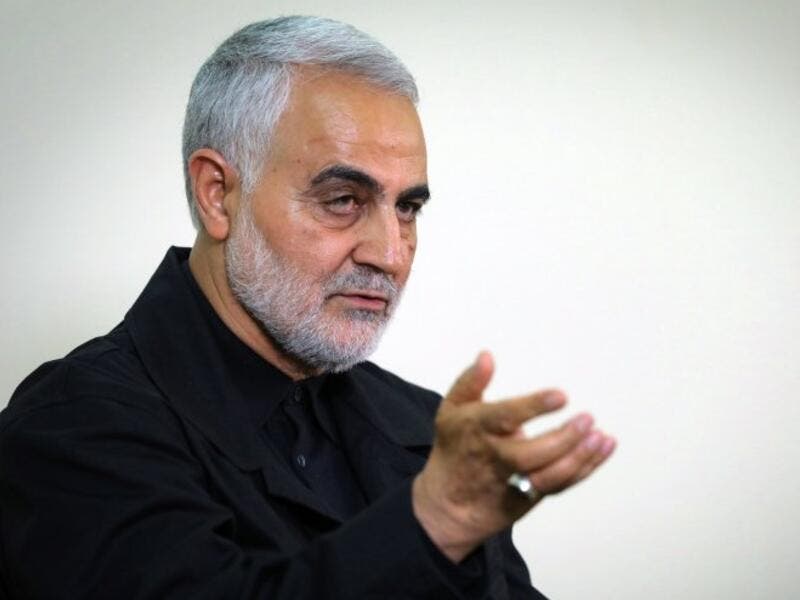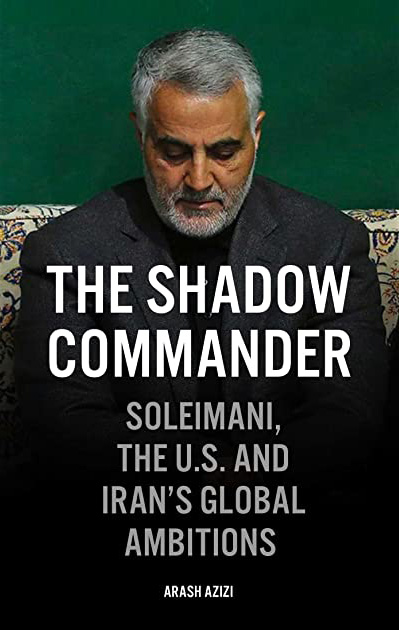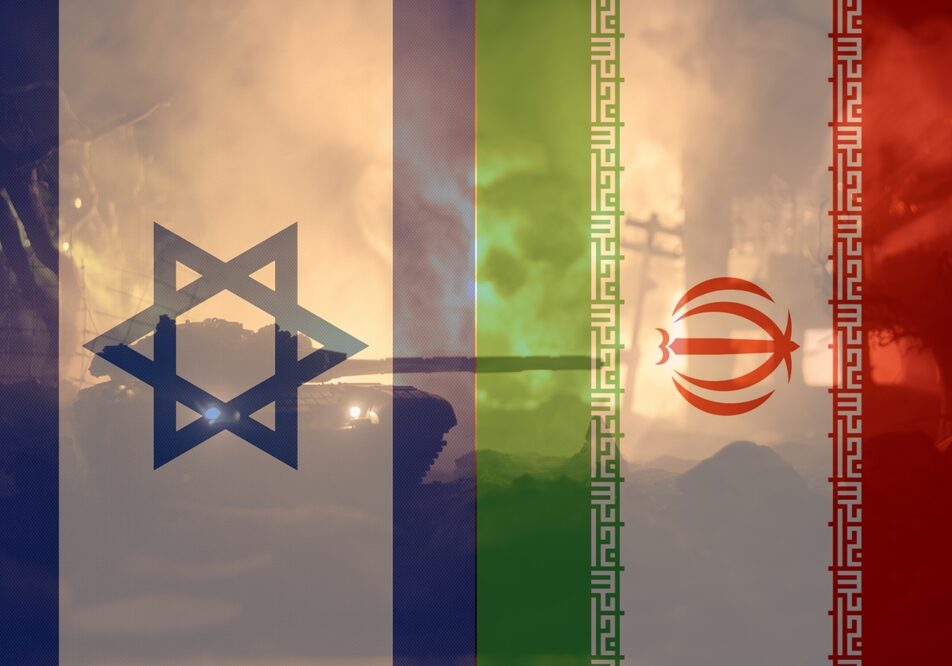Australia/Israel Review
Biblio File: The Life of a Celebrated Mass Killer
Feb 2, 2021 | Peter Theroux

 The Shadow Commander: Soleimani, the US and Iran’s Global Ambitions
The Shadow Commander: Soleimani, the US and Iran’s Global Ambitions
Arash Azizi, Oneworld, 2021, 320pp., RRP$41.65
Late in Arash Azizi’s fluent and groundbreaking new biography of the late Qassem Soleimani, The Shadow Commander: Soleimani, the US, and Iran’s Global Ambitions, the author tells us that the summer before Soleimani was killed, “Israel’s former prime minister Ehud Olmert spoke of his old adversary Soleimani in a radio interview: ‘There is something that he knows, that he knows I know, that I know he knows, and both of us know what that something is.’ He paused for a moment and added: ‘What that is, that’s another story.’”
Welcome to the shadows. Azizi reads Olmert’s remarks as a threat, and perhaps they were, but amid the apocalyptic and violent threats launched from Teheran over 40 years – mostly directed at Olmert’s country – the former Israeli PM sounds positively neighbourly.
Soleimani’s hatred of Israel was obsessive. So many things he touched were named Quds (the Arabic name for Jerusalem ) – the Quds Training Barracks, the Islamic Revolutionary Guard Corps’ (IRGC) Quds Force, and a couple of operations in the Iran-Iraq War.
Soleimani endured a Dickensian rural boyhood of shame due to impoverishing family debt and menial jobs. He moved on to steady work, a love for karate, a fondness for Scarface-style men’s fashion outfits, and religious radicalisation. With the coming of the revolution in 1978 and then the Iran-Iraq War, he sought ever closer engagement at the front, as a member of the nascent IRGC, a militia “which grew to overshadow and dwarf the army … [Soleimani’s] calm and quiet demeanour did little to hide his ambition. He planned to make this war his own.”
He was wounded in the grandly titled “Operation Path to Jerusalem”, which more modestly did liberate the town of Bostan from Iraqi control.
The Iran-Iraq War showcased the fearlessness within the young Soleimani’s damaged psyche. His role in operations “Dawn 8” and “Karbala 4” are noted twice and both operations were debacles. The butcher’s bill of Karbala 4 and 5, indeed the whole futile Iranian war against Iraq from 1982-88, was atrocious – James Buchan called it the greatest catastrophe to befall Iran since the Mongol invasions – but in Soleimani’s world view there was no disaster nor guilt.
The self-aggrandisement and tolerance for slaughter that were planted in Soleimani’s youth achieved their peak during the destruction of Syria in order to buttress the Assad regime and the near destruction of Lebanon through the arming of Hezbollah and backing of its attacks on Israel. Soleimani was also particularly proud of the IRGC’s role in arming Hamas and Palestinian Islamic Jihad and training their bomb-makers and logistics officers to wage missile warfare and suicide attacks. Azizi offers a superb account of the latter group’s suicide bomb attack at the Maxim restaurant in Haifa in October 2003 and of the IRGC’s real-time delight at the bloodshed from the Quds Force safe room in Damascus.
“As Yasser Arafat condemned the attack in the strongest terms,” we read, “the Iranians were jubilant at the credibility it would bring them.”
Following the terror attacks on the United States on Sept. 11, 2001, American diplomat Ryan Crocker opened a diplomatic channel to the Iranians on working together against al-Qaeda. Shortly thereafter, in January 2002, US President George W. Bush scolded Teheran as being part of an “Axis of Evil.” In Washington DC mythology, the president’s description of Teheran’s elites – “an unelected few repress[ing] the Iranian people’s hope for freedom” and “pursuing nuclear weapons” – so offended the Iranians that their negotiators quit, and American diplomats experienced a “traumatic moment.”
My own tiny mind boggles at the fact that a regime, that kept up a daily stream of insults at the United States, with “Death to America” being chanted in its parliament, mosques, and schools, along with ritual immolation and trampling of the American flag for four decades, retreated to a fainting couch at a single insulting reference in a speech and ruled out working together against al-Qaeda – many of whose surviving leaders found refuge in Teheran.
Whether Soleimani and his IRGC cohort preferred to partner with Osama bin Laden, or whether Bush’s words were the cause, Soleimani was spared the prospect of partnering with the United States until negotiations came to fruition in Barack Obama’s second term. The first locus of that cooperation was in support of the mass-murdering regime of Bashar al-Assad in Syria, whose survival Obama committed to recognising as an Iranian “interest” that the US would accommodate in his blueprint for a new regional security architecture.
Yet the Iranian regime itself was hardly unanimous in its embrace of Syria’s brutal and corrupt tyrant. “We knew Assad was a dictator with no religion,” a Quds Force member said – Assad is an Alawite, considered by some Muslims to be heretical. “Some people grumbled about this early on. But when it became clear that the leader had decided personally on this strategy, we all obeyed.”
By the time the Arab Spring reached Syria, Teheran had decided that this Baathist domino must not fall. The Iranian Foreign Ministry and army were sidelined, and the entire pro-Damascus project given to the IRGC. “Iran would later link its massive armed intervention in Syria to the rise of ISIS,” Azizi writes, but “evidence suggests otherwise. From the very moment Assad faced popular protests, the Quds Force and Teheran were ready to do all they could to save the rule of the Baath Party.”
ISIS – “an American-Zionist group,” in Soleimani’s words – became the IRGC’s target in Iraq after the Americans agreed to withdraw. The Iran-Iraq War was part of a decidedly imperialist Iranian strategy of controlling foreign lands through powerful militias that answered to Teheran. After Hezbollah in Lebanon came Kata’ib Hezbollah in Iraq among others, which included Afghan and Pakistani mercenaries recruited by Iranian agents with Iranian – and later American – money. The formerly discreet Soleimani now strutted around these ruined domains like a Roman proconsul, seeing only proud conquest – his basis of comparison being poverty, carnage, and short, brutal lives that had become normal in Iran under Khomeinist rule.
Azizi is a skilful interpreter of Soleimani’s moves, and an astute analyst of how Iran’s “living martyr” lied, schemed, and abetted the ugly torture and murder of true revolutionaries and Muslims across the Middle East, and wherever else the IRGC’s reach permitted. The supposedly humble and obedient patriot from Kerman sought and achieved authority at the highest levels of Iran’s military and terrorist power structure, and was the second-most-powerful man in the regime at the time of his death.
Even so, some of Azizi’s revelations verge on the amazing. He records Soleimani’s direct order for a Houthi sniper to kill former President Ali Abdullah Saleh of Yemen. In a well-sourced work of history, this nugget is not footnoted, but it seems consistent with Soleimani’s callousness, especially given Saleh’s on-and-off ties to the United States and Saudi Arabia. Yet how many critics of the American action to kill Soleimani knew of the latter’s own order to murder a foreign head of state – and a Shi’ite Muslim one at that? Further, Azizi asserts that the militia rioting and siege at the US Embassy in Baghdad in January 2020 – almost a mirror image of Teheran in 1979 – occurred on a direct order from Soleimani.
Azizi is also at his best sketching out the complex and shifting array of the pre-revolution feuds and alliances among Iranians in the diaspora.
The devout, canny, Qom-born Sayyid Musa Sadr in Lebanon exemplified one model of patriotic soft power – “one of the most successful transnational transplantations of a political figure in modern history.” Azizi also places Ali Shariati, Mostafa Chamran, and Ebrahim Yazdi in this company. Had Teheran gone the Shi’ite soft power route, versus its choice to export the revolution, it might today be a dominant and peaceful regional power enjoying good relations with Washington and the West.
Soleimani’s death was greeted with both mourning and rejoicing inside Iran. Azizi describes the joy of Syrians at the news; their country had been savaged by the Baath regime and its Iranian overlords. Iranians, particularly the young and freedom-seeking, would have remembered the paramilitary violence against protesters that Soleimani had personally urged on. They may also have appreciated that the American missiles that incinerated him had spared them his final ambition: “In November 2019, [Soleimani] asked some of his men to look into a presidential run.”
Against a backdrop of solid history and ground-breaking reporting, it seems almost churlish to note a few errors of fact in Azizi’s fine book. Richard Nixon served in the US Congress as a representative and senator from California, not its governor, as Azizi writes. The Lebanese Phalange Party’s armed men, not the Israel-backed South Lebanon Army, committed the massacres in Sabra and Shatila. There are other such examples, none of them major.
Understandably, bin Laden merits few mentions in Azizi’s book, since the two killers never met, and yet to grasp Soleimani it is worth a comparison with his Arab coeval (the two men may have been born less than a week apart in March 1957; historians spar over the three possible birth dates for Soleimani, with Azizi favouring the earliest one). They had much in common: high intelligence, a flair for theatrics and motivational speaking, and similar pathologies rooted in early-life humiliation. Both showed the world, and their closest confidantes, modest, humble, and soft-spoken exteriors that masked ruthless egoism and bloodlust.
Some parallels originate in the two regional wars birthed by the Islamic revolution. Iran’s torching of its relations with its American ally, and the diplomatic isolation brought on by the hostage-taking of American diplomats – plus the purge of its own senior military personnel (possibly exceeding 12,000, according to historian Abbas Amanat) – emboldened the Soviet Union to invade Afghanistan and Iraq to invade Iran, two aggressions unthinkable had the Shah been in power. The Afghan jihad shaped bin Laden as the Iran-Iraq War shaped Soleimani. Both budding psychopaths experienced slaughter at an early age, and both men’s world views were formed during the barbarities of those wars, both of which were consequences of a revolution that was a disaster not only for Iran but for multiple neighbouring countries – yet is still often treated as a somehow necessary and desirable consequence of the Shah’s rule, for which the United States is assumed to bear a large portion of responsibility.
Shaped by the consequences of the Iranian revolution, bin Laden and Soleimani became new-style heroes of anti-American jihad running vivid but divergent public relations campaigns. In the mid-2000s, bin Laden suddenly ceased appearing in open-air al-Qaeda propaganda videos. The doe-eyed mujahid, raised in Saudi Arabian luxury, had seemed to relish a soldierly image, clambering over boulders for the camera with his sidekick Ayman al-Zawahiri, or humping his backpack and Russian rifle over rugged terrain in Afghanistan during the war against the Soviets. A wide-shot video clip of a heavily armed bin Laden and al-Zawahiri navigating a steep hike down a gully, stepping like mountain goats while preaching jihad to the camera, probably altered his fondness for outdoor theatrics: Legend has it that the US intelligence community ran the clip past botanists, geologists, and lepidopterists, who studied the rock formations, birdsong in the background, butterflies, and the slant of the sun, and are said to have identified almost to the exact day and square kilometre the site in Helmand Province where the clip was shot. Bin Laden quickly adapted to a more cautious Punch-and-Judy puppet show format where he spoke within a sort of little stage within a tent with a colourful fabric background, until he later dispensed with video altogether in favour of audio maledictions.
Soleimani’s trajectory when it came to discretion versus preening was the opposite. After 20 years in the shadows, he hit his stride in Iraq, Syria, and Yemen, and seemed to relish that he enjoyed the de facto protection of American power after the 2015 nuclear deal. His threats grew bolder, promising a “bloody intifada” in Bahrain in June 2016 and mocking President Donald Trump in a famously boastful speech in July 2018. He promiscuously immortalised visits to his militia fighters in Iraq with selfies. Whereas bin Laden knew he was being hunted, Soleimani seemed confident that he wasn’t. Azizi cites Ryan Crocker as observing that the general “allowed his ego to overcome his judgment… The shadow commander came out of the shadows. He did not live long beyond that world of shadows.”
Peter Theroux is a Los Angeles-based writer and translator. This article is reprinted from Tablet Magazine, at tabletmag.com, the online magazine of Jewish news, ideas, and culture. © Tablet Magazine, reprinted by permission, all rights reserved.
Tags: Iran, Qassem Soleimani






